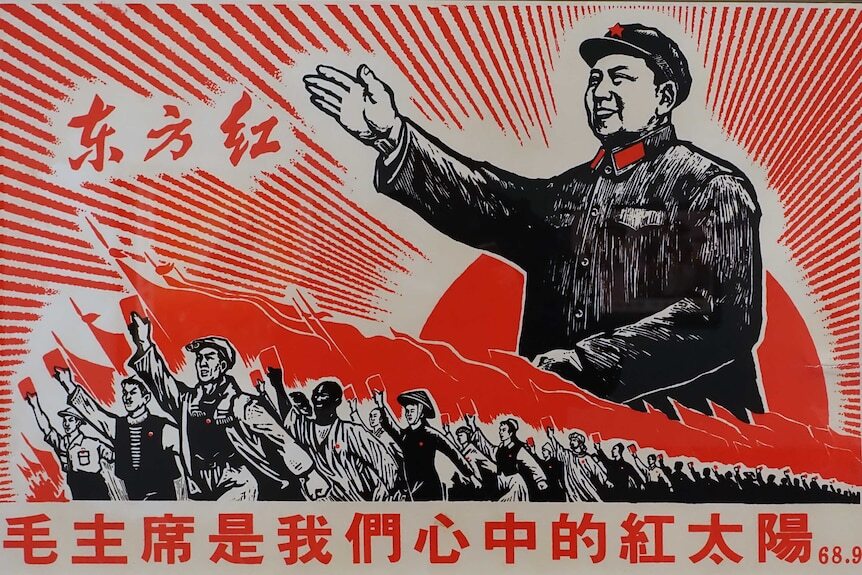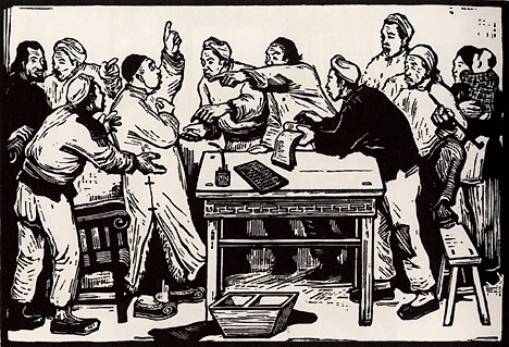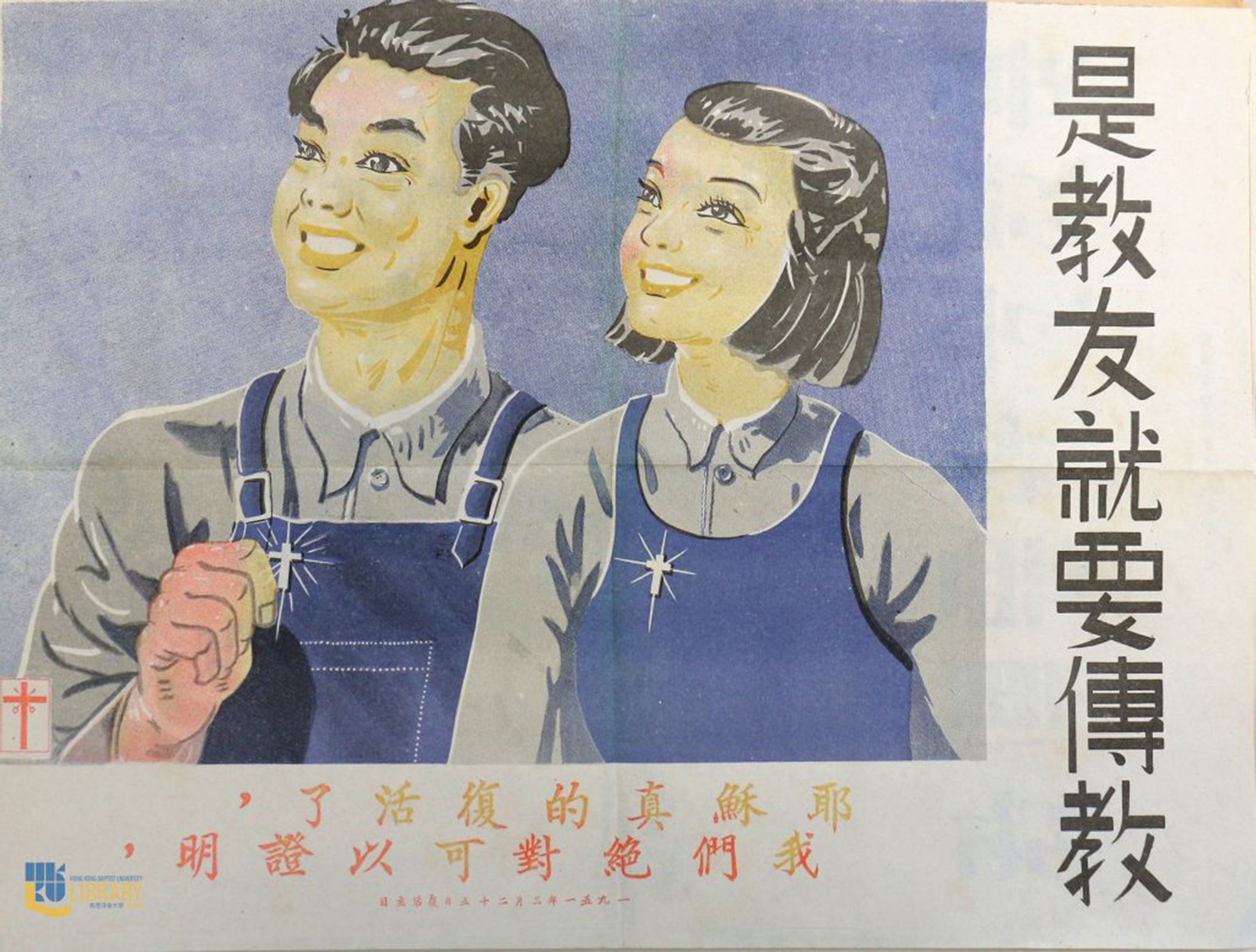
When I was first introduced to the Chinese Christian Posters, I was struck with how vibrant and lively the posters were. The first among them to ever take me aback was the “Preach Christ, Reform China” poster (Image on the left) from 1927. It features Jesus directing an army of evangelists against a retreating entourage of dark, ghostly figures. The white flags the evangelists carry have slogans such as “Justice”, “Humanity”, “Cooperation”, and “Equality”. The dark figures, on the other hand, have black flags that say “Laziness”, “Cruelty”, “Greed”, and “Social Class”. In addition to the white flags, the evangelists have Bibles in their hands. The most striking element of the poster is the figure of Jesus Christ looming over the wave of people below as he directs them forward. This poster exudes themes of Nationalism. As one would assume from the political climate in America today, to involve Christianity with nationalism is bold, and in some views, controversial. However, the creators of this poster, the National Christian Council, didn’t see it as controversial, but rather as an opportunity for Christianity. “The chair of the NCC Yu Rizahng […] believed that the strength and aspiration lease by nationalism—‘a popular movement of the people’—could be a powerful ally in Christianization of China” (Sun, 69).
Despite this advocation of nationalism among Chinese Christian organizations and the belief of self-determinism for China, Christianity in China had historical ties to the West, of which engaged in imperialism and colonialism in China. Because of this association, it was easy for rival organizations to use this as a talking point against Christianity. One such organization was the Communist Party of China. According to “The Communist Party propagated Christianity as a devil for Chinese people and reportedly condemned that ‘the progress of Christianity is due to the support it has given to imperialistic government methods,’ a prevent teaching that the Communists learned from Russia. From the Christian standpoint, however, these people who accepted the Communist accusation against Christianity of invading China were without historical knowledge. It was essential to advertise the positive image of Christianity among the Chinese and demonstrate that Christians had no reason to challenge the stability of China. Communists not only distributed literature condemning Christianity but also competed with Christianity in attracting China’s youth” (Liu, 2021). One such advertisement that embodied this rebuke against the accusations made of Christianity is “The Eighth National Convention of the Chinese YMCA” (see image on the right). The poster depicts an ocean of people looking at the logo for the Chinese YMCA, which replaces the sun. The red letters in the center say “Tomorrow’s China.” Using a mass of people in posters expresses a unified spirit of the collective and to create an atmosphere of grandness and importance, of which this poster used excellently. This poster expresses a severing of its western association and focuses on China and its future, expressing its spirit to become a part of it.



One could see the similarities between “Preach Christ, Reform China” and the later Chinese Communist posters featuring Mao (see image at the upper right). In this poster, Mao looms over an army of revolutionaries, directing them. The revolutionaries march with red flags and books, most likely the infamous “Little Red Book” of Mao’s sayings. Not only are there similarities in visual elements, but also, as one could claim, religious elements as well: Mao as the Messiah of Chinese Communism leading believers to the future as they carry flags of “values” and books of Mao’s words. The similarities of visual elements between this poster and the previous one come from similar interests, as “the Christian establishment and the revolutionary parties both agreed on one thing: the need for a strong China” (Sun, 69). I also believe that the previous poster and others like it (including those lost to history) were inspirations for the Chinese communist posters. When my class had the pleasure of talking with Daryl Ireland, he mentioned that the communists used woodcut techniques for their posters. Last I remembered, he shared that the woodcut style wasn’t as popular as the Christian posters, as people saw them as bland (see image to the bottom right). Over time, Chinese communist posters evolved and became less Chinese and became more westernized. While “before the communist takeover in 1949, most modern illustrators and designers were trained as commercial artists, using western styles [… and] Chinese art academies after 1949 were taught by Soviet artists employing the “socialist realism” practiced in the communist world” (Powell and Wong, 1997), I believe the artistic creativity of the Chinese Christian posters, and the people’s negative response to the Chinese communist, posters that the Chinese communist to reevaluate their propaganda production.
This poster, “All Believers Should Spread the Gospel” (see image on the right) would very easily be confused as an early prototype of communist posters. However, a cross can be seen on the clothing of the two youths. Their amazing grins with gazes looking up and away with optimism can be familiar to those we have seen communist posters before. Additionally, the text being used, “all believers should spread the gospel” uses a very similar tone that communists would use on their posters, creating a moral expectation of the viewer. The use of youths is an expression by the creators that their organization and mission are still alive. Unfortunately, this poster was made after the revolution and was a level down of Christian expression as a result when large, red crosses were used. According to Ireland, commenting on the same poster, “Before 1949, the cross loomed over posters. Afterward, crosses still appeared, but in truncated form. Quietly the cross was drained of its power. The few crosses that appeared became little more than a shorthand for Christianity […] a sign that the building is a Christian structure rather than a particular theological statement. In a poster from the next year, two youths wear crosses on their clothes that sparkle. The crosses are meant to draw the eye and mark the energetic young workers as Christians, but again, it would be difficult to say much more. Crosses no longer have rich or layered meanings. They are just generic references to Christianity” (Ireland, 2022).

While most is lost history, a few posters have remain that still carry the nationalistic movements of the past.
Sun, Zexi. “Nationalism”. Ireland, Daryl R., ed. Visions of Salvation: Chinese Christian Posters in an Age of Revolution, pp. 53-73. Baylor University Press, 2023.
Powell, Patricia, and Joseph Wong. “Propaganda posters from the Chinese cultural revolution.” The Historian 59, no. 4 (1997): 777-794.
Liu, Lingshu. “Silent Messengers: Visualizing the Growth of Christianity in China by Chinese Christian Posters, 1927-1942.” Order No. 28318611, University of Washington, (2021). http://proxy.lib.ohio-state.edu/login?url=https://www.proquest.com/dissertations-theses/silent-messengers-visualizing-growth-christianity/docview/2522418325/se-2.
Ireland, Daryl R., and David Li. “Lift High the Cross: The Visual Message of Popular Chinese Christianity.” International Bulletin of Mission Research 46, no. 4 (2022): 474-491.
